



Keeping Chameleons in Glass Terrariums
By Christopher V. Anderson
Citation:
Anderson, C.V. (2010). Keeping Chameleons in Glass Terrariums. Chameleons! Online E-Zine, July 2010. (http://www.chameleonnews.com/10JulAndersonGlass.html)
For many years the standard for keeping chameleons has been to house them in enclosures made of screen or wire mesh. Because chameleons generally require taller enclosures with excellent ventilation, these screen-sided enclosures provide a relatively inexpensive source of housing that provides high levels of airflow and plenty of fresh air. Unfortunately, this standard of keeping has resulting in a widespread negative stigma and general misconception that you cannot keep chameleons in glass enclosures.
On the contrary, many keepers successfully keep many different chameleon species in glass enclosures. Having said that, however, it is important to differentiate between different types of glass enclosures, rather than simply assume that any glass enclosure makes a good chameleon enclosure.
Glass enclosures can broadly be divided into two types: aquariums and glass terrariums. These two types of glass enclosures vary in their purpose, as well as their appropriateness for keeping chameleons.
Aquariums are primarily designed to hold water and keep fish. They are not designed for airflow and even with screen tops, a large portion of the aquarium gets very poor airflow. Many aquariums are marketed as terrariums for keeping reptiles because they are made of thinner glass that cannot handle the weight and pressure of being filled with water, but their design is otherwise the same and they do not qualify as glass terrariums as I am describing them.
Glass terrariums are not designed to keep fish and are designed for airflow. They typically have screen mesh venting at the top of the enclosure and venting at the lower portion of one of the sides, often the front. The layout of these vents is critical toward explaining why these enclosures provide increased levels of air exchange. Their arrangement serves to create a chimney effect where as air warms in the enclosure, it rises and leaves through the top of the enclosure. As this warmed air rises, it frees up space inside the enclosure, thus drawing fresh air into the enclosure through the vent at the bottom side of the enclosure. The result is the efficient exchange of air in the enclosure providing continuous fresh air.
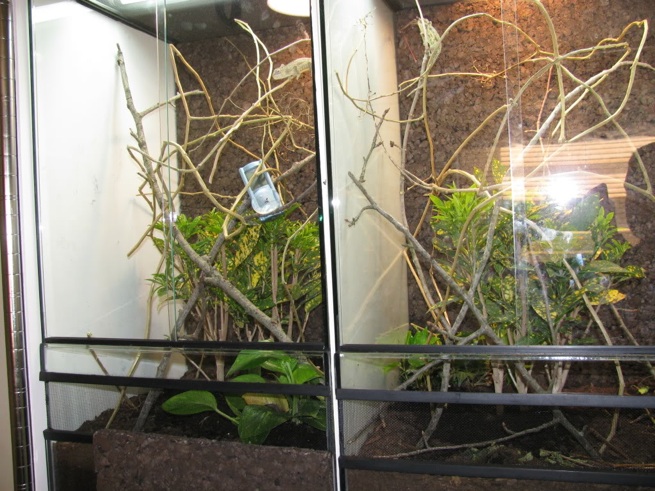
Simply put, aquariums are not good chameleon enclosures. First, few aquariums provide the vertical height required by chameleons. While some terrestrial species (pygmy chameleons) can be kept in them, this is simply because they live close to the ground and in these short enclosures, the top of the enclosure is not far from the bottom of the cage, thus allowing some airflow to be exchanged. For arboreal species, however, the enclosures need to be taller resulting in the distance between the source of fresh air and the bottom of the cage being larger and thus, less air exchange.
Breeders in Europe have kept many chameleon species in glass terrariums for decades with excellent results. In the US, glass terrariums have not been commercially available until relatively recently. Up until this point, a glass enclosure automatically meant an aquarium and the majority of US keepers didn't know the distinction between glass terrariums and glass aquariums—glass was glass.
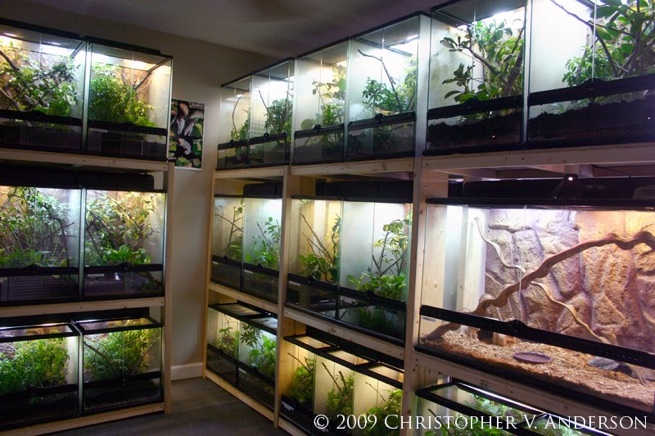
Now that true glass terrariums are available from a couple commercial sources, such as Exo-Terra and Protean Terrarium Designs, a few US chameleon keepers have started experimenting with keeping chameleons in them. Similar to our European counterparts, these have been with great results. Keeping in glass enclosures does require some changes in your husbandry techniques, however.
First, I have found that it is best to fully plant each glass terrarium with live plants, much like you would for a pygmy chameleon terrarium. I use an inch to an inch and a half layer of hydroton pebbles on the bottom for drainage, which I then cover with a layer of plastic window screen to maintain separation between the layers. I then plant a variety of live plants in the terrarium using organic potting soil. I try to have a combination of plants that will provide ground cover as well as arboreal foliage. I then seed the enclosure with springtails to act as a natural cleaning crew.
While some may claim that planting the terrarium poses a risk of ingestion of the substrate and subsequent impaction, I argue that there is no more risk of impaction then there would be for pygmy chameleons, which are routinely housed in fully planted enclosures, and that the benefits outweigh the risks as long as you are careful to observe your animals. By planting the enclosure, the plants grow better and remain fuller, there is natural drainage and no water buildup in the bottom of the enclosure, there are increased humidity levels in the enclosure, and it provides for a nicer looking setup in general that both you and your animal will appreciate. Of course, if an animal is observed actively consuming the soil, that animal should be housed in an enclosure without a soil substrate, but this is a rare occurrence and usually indicative of a nutritional issue that needs to be addressed.
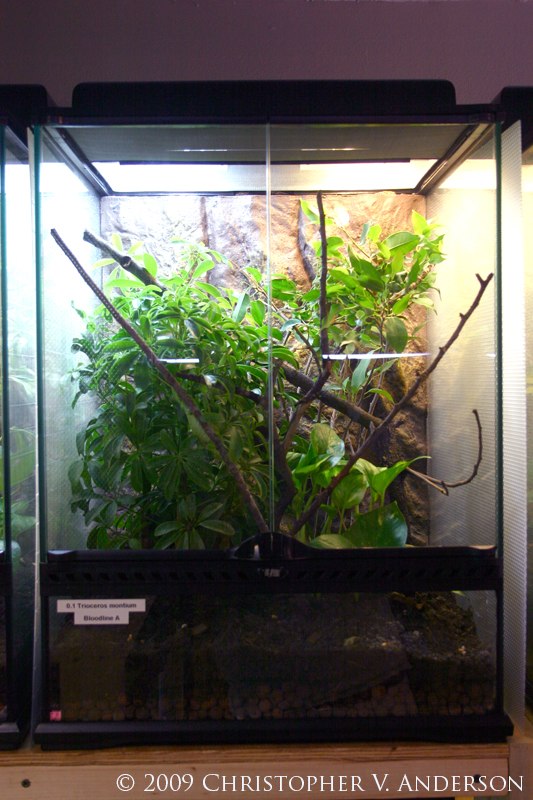
A typical, fully planted 18”x18”x24” Exo-Terra Glass Terrarium the author uses to house adult montane chameleons. Ventilation is present immediately under the doors.
Next, because screen enclosures fail to maintain humidity well, often resulting in a dry interior environment, many chameleon keepers have gotten into the habit of misting their chameleon enclosures 3 or more times a day for prolonged periods each time in order to make sure their chameleons are able to drink plenty and humidity is maintained. This often requires elaborate drainage systems and a considerable amount of time and water every day. Fortunately, because glass terrariums maintain humidity better, chameleons do not need to be misted as frequently or for as long when housed in them. Montane species I previously misted twice a day for 20 minutes each misting when I kept them in screen enclosures, I now keep in glass terrariums and only mist once to twice per day for about a minute when using a handheld pressure sprayer or about 2 minutes with a MistKing mist system. This amount of misting thoroughly waters the enclosure providing ample water for the chameleon to drink and the humidity is maintained, thus resulting in a lower drinking requirement. Because the terrarium is planted, excess water is absorbed into the soil, watering the plants. Care must be taken to ensure the enclosure dries between misting sessions, but misting once or twice a day easily allows for this.
Finally, because glass maintains temperature better then mesh enclosures, a smaller wattage heat source is typically needed. For some species, little more than the heat from the UV lights is required for basking, however requirements will vary based on the species and enclosure size and layout. Using an infrared thermometer will easily provide you with the information needed to make sure temperatures are appropriate.
It is important to note that these enclosures should only be used for appropriately sized species. Adult male Veiled Chameleons (Chamaeleo calyptratus) or Panther Chameleons (Furcifer pardalis) require larger enclosures than are currently offered by many of these glass terrarium suppliers. Some sources, however, will custom build you enclosures of your desired dimensions, in which case adult males of these species could easily be kept in them. At large sizes, however, the enclosures become very heavy.
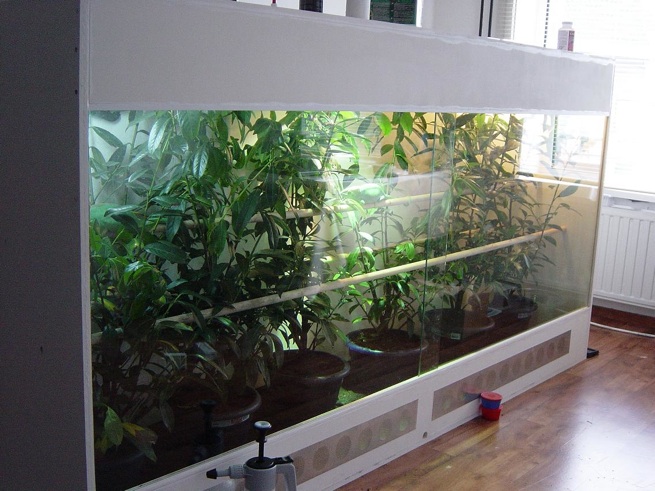
To get around the weight issue, many European keepers will construct their own large terrariums from solid walls and only use glass or plexiglass for the doors. These custom built enclosures are outfitted with ventilation low on the sides and a screen top, allowing for ventilation in these enclosures as well.
One of the biggest advantages of glass terrariums is their use in raising babies. When kept in small (12”x12”x18”), fully planted glass terrariums, baby chameleons flourish and grow quickly. The enclosures hold fruitflies much better than open toped baby tubs or your typical screen topped baby-rearing enclosure, and maintain humidity, while still allowing sufficient airflow better than other techniques. Because the humidity levels are maintained better in these enclosures, misting is required less frequently, with superior results.
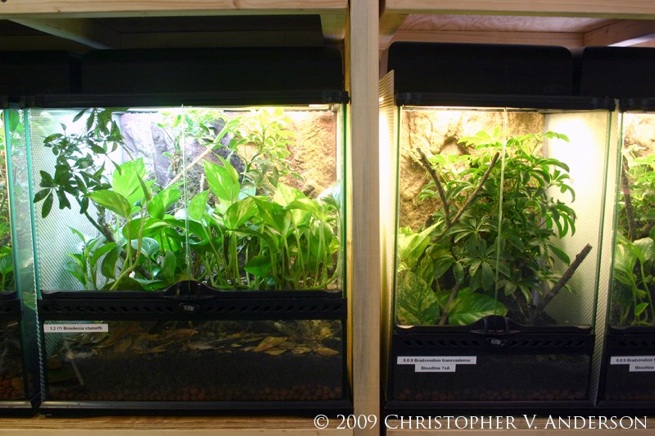
As with any chameleon setup, keeping chameleons in glass terrariums requires consistent care efforts and attention to detail. While care techniques in these enclosures are slightly different than in screen enclosures, glass terrariums are much easier to maintain in many ways and also provide a much more visually appealing enclosure for your chameleons.

Christopher V. Anderson

Chris Anderson started keeping chameleons in 1997 and since then has worked with over 50 different species. Having spent time in the jungles of South East Asia, among other areas, aiding in research for publication, he has traveled to over 35 countries, including chameleon habitat in 6. Included in these, he has traveled throughout Madagascar in search of, and conducting personal research on the chameleons of the region. Having received his B.S. in Animal Science from Cornell University, Chris is currently a Ph.D. Candidate at the University of South Florida’s Department of Integrative Biology studying the effects of temperature on ballistic tongue projection and tongue retraction in chameleons for his dissertation. Some of his research has been published in top scientific journals and featured in popular press and news outlets all over the world. Currently, Chris is the Editor and Webmaster of the Chameleons! Online E-Zine. Chris’ personal website can be found at www.chamaeleonidae.com and he can be emailed at Chris.Anderson@chameleonnews.com or cvanders@mail.usf.edu.









Join Our Facebook Page for Updates on New Issues:
© 2002-2014 Chameleonnews.com All rights reserved.
Reproduction in whole or part expressly forbidden without permission from the publisher. For permission, please contact the editor at editor@chameleonnews.com
